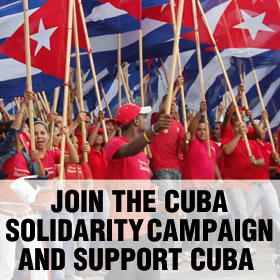CUBA-AFRICA: Decades of assistance
Campaign News | Friday, 2 July 2004
Since 1963 Cuba has helped thousands of people in Africa
By Patricia Grogg of the Inter Press Service News Agency
HAVANA, Jul 2 (IPS) - Dozens of countries in Africa benefit from medical or other assistance programmes from Cuba, and in four decades this socialist island nation has helped train around 30,000 young people from that continent in a number of specialties.
Medical assistance, which began in 1963 when Cuba sent health brigades to Algeria, has been extended to more than 20 nations, 16 of which are included in the Integral Health Programme, which also encompasses seven countries in Latin America and two in Asia.
"Cooperation in that field is still the most important. By the end of 2003, we had 2,574 collaborators in Africa, most of them in the area of health," Milagros Franco, the Ministry of Foreign Investment's director for Africa, told IPS.
The aid has had a strong impact. According to official statistics, infant mortality in areas where Cuban medical professionals provide assistance has plunged: from 59 to 7.8 per 1,000 live births in Ghana, from 48 to 10.6 in Eritrea, and from 131 to 35.5 in Equatorial Guinea.
The assistance includes training of health workers in the areas where Cuban doctors provide their services and of health professionals in institutes in Cuba.
Havana has also helped set up medical schools in Gambia and Equatorial Guinea, and Cuban professors teach in medical schools in several countries, including Ethiopia, Uganda and South Africa.
Cuba has diplomatic ties with 53 African nations and provides assistance to 51. Although the greatest emphasis is put on health and education, cooperation also includes the areas of sports, construction, agriculture and urban planning.
"The cooperation is based in first place on the training and development of human resources and on our commitment to that region, with which we have historical, as well as blood, ties," said Franco.
According to official statistics, around 6.3 percent of Cuba's 11.2 million people are university graduates, and Cuba has around 64 centres of higher learning, in which a combined total of 200,000 students are enrolled.
Political leaders in Africa especially value the aid provided by Cuban doctors in fighting pandemics like tuberculosis and HIV/AIDS, in clinics which are often located in remote regions, and in specific programmes in the area of prevention, for instance.
As part of an agreement signed with Botswana in 2002, Cuban health professionals work in several hospitals and clinics that specialise in treating those living with HIV/AIDS in that southern African nation.
An estimated 29 million people are living with HIV/AIDS in sub-Saharan Africa.
Cuba helped many countries in that region in their independence struggles, but the fight has not ended -- it is just a different war now, a government official from Botswana recently told the press on a visit to Havana.
Botswana, which has a population of 1.8 million, has the highest proportion of people living with HIV on the planet, with 36 percent of people between the ages of 15 and 49 infected.
"All of this collaboration is carried out on a basis of respect, with the idea of resolving concrete problems, and without taking jobs from professionals from those countries," said Liber Puente, a specialist in relations with sub-Saharan Africa in Cuba's Foreign Ministry.
Puente added that many youngsters who have studied on scholarships from the Cuban government are today professionals working for the development of their countries and holding political leadership and government posts.
Claude Grace Uushona, Namibian Ambassador in Havana, is one such case. She first arrived in Cuba at the age of 16, injured and with horror written on her face after the massacre she witnessed in a refugee camp in Cassinga, in southern Angola.
"It was a camp for women and children refugees located 250 km from the border with Namibia. On May 4, 1978, South African forces bombed us with military helicopters and planes," she told IPS.
The survivors, many of whom were pre-adolescents and adolescents, were invited by President Fidel Castro to travel to Cuba to attend school on the Isla de la Juventud (the Island of Youth), to the south of Cuba.
"There were about 600 of us who came. I went to high school and prep school there. Then I studied at the University of Gambia and I became the first woman governor in Namibia. Now I am very happy to be in my second country again," Uushona added.
Cuba and Namibia established diplomatic ties on Mar. 21, 1990, the day the southwest African nation declared independence. Since then the two countries have engaged in a number of cooperation programmes in areas like health, education and sports.
Namibia is now the biggest recipient of Cuban investment in Africa, with two Cuban-Namibian fishing companies and mixed ventures that manufacture guayaberas -- the typical Caribbean men's shirt -- and generic medicines.
Uushona said the companies are very important for the development of Namibia.
The ambassador recalled that the victory of Cuban and Angolan troops fighting alongside the guerrilla Southwest African People's Organisation (SWAPO) against South Africa's apartheid army in the April 1988 battle of Cuito Cuanavale in southern Angola played a decisive role in the liberation of Namibia.
Pretoria, after it was defeated in its last major offensive in Angolan territory, was forced to accept the tripartite accords with Angola and Cuba that led to the withdrawal of South Africa's army from Namibia, and in November 1989 Namibia held elections for a constituent assembly.
Since then, SWAPO has been the governing party in Namibia.
The tripartite accords also led to the gradual withdrawal of the Cuban military contingents from Angola, and the start of the abolition of South Africa's racist apartheid regime.
An estimated 300,000 Cubans passed through Angola between 1975 and 1989, including 2,016 who were killed.
http://ipsnews.net/interna.asp?idnews=24464






